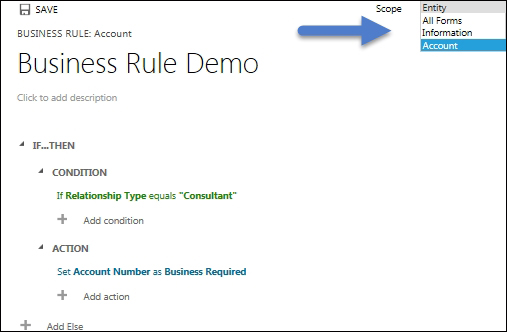This chapter will help you understand the basics of Microsoft Dynamics CRM 2015. We will be discussing an overview of the new features released in CRM 2015 and also we will be discussing the upcoming features of CRM 2015 Update 1. In a later chapter, we will work on these features in detail and will see how we can use them for implementing different requirements. We will discuss the following topics in this chapter:
Introduction to Microsoft Dynamics CRM 2015
The deployment options available
Online versus on-premise
The available clients
The software and hardware requirements
The upgrade options
The license model in Microsoft Dynamics CRM 2015
The new features in Microsoft Dynamics CRM 2015
Based on the Microsoft Dynamics CRM road map presented in Microsoft Dynamics Convergence 2014, Microsoft announced general availability of Microsoft Dynamics CRM 2015 code name "Vega" on November 30, 2014. This is a major release for Microsoft Dynamics CRM after Microsoft Dynamics CRM 2013 release. Microsoft Dynamics CRM 2015 introduced many new exciting features for every type of CRM users such as Administrators, Functional and Technical Consultants, and Developers. Microsoft Dynamics CRM 2015 also enhanced some of the features that were released in Microsoft Dynamics CRM 2013. After the CRM 2015 release, another release that is lined up is CRM 2015 Update 1, which will introduce another set of exciting features. We will be discussing more on these features in a later topic.
Similar to the earlier version, this time, the Microsoft CRM development team did not redesign the Microsoft Dynamics CRM interface. All the UI and navigation is the same as that of Microsoft Dynamics CRM 2013, except the new navigation group added with the advance find button and global search box on the top navigation bar. The new navigation group has also added for accessing security features:

Microsoft Dynamics CRM 2015 mainly added features to Sales with the Dynamics Marketing and Social Listening components. Microsoft Dynamics CRM 2015 also supports accessing its records using voice commands. Cortana, an intelligent personal assistant, which is a part of Windows Phone 8.1, can be used for Microsoft Dynamics CRM 2015. So, the customers who use Windows Phone 8.1 can use voice commands to create activity records, such as appointments, tasks, phone, search and navigate to entity records.
Note
This app can be downloaded from http://windows.microsoft.com/en-us/windows-8/cortana.
The different Microsoft Dynamics CRM 2015 deployment options can be considered based on the resources available. The following are the different options available for Microsoft Dynamics CRM 2015:
On-premise: Microsoft Dynamics CRM 2015 on-premise is installed on our own server, so we need IT and infrastructure support to install and set up CRM 2015 and the related software applications. If we have the infrastructure that is compatible with CRM 2015, we can reuse it; otherwise, we need to set up a new server or virtual servers based on our requirement.
Note
Refer to the software and hardware requirement section for details on hardware and software requirements for CRM 2015.
The Microsoft Dynamics CRM 2015 on-premise server is available with two editions as follows:
Note
More information on CRM 2015 servers can be found at https://technet.microsoft.com/en-us/library/hh699677.aspx.
Online: Microsoft Dynamics CRM 2015 online, also known as cloud, is hosted on Microsoft's data centers. All the required infrastructure is handled by Microsoft, so we don't require any servers. Microsoft also provides access to nonproduction instances, which can be used for development or testing purposes based on the number of users in our production organization. Currently, we need to have 25 or more professional USLs to get nonproduction instances.
Hosted: Hosted deployment is a mix of on-premise and online deployment. Here, a CRM application is hosted on a third-party vendor instead of Microsoft and the services are dependent on the service agreement with the CRM service provider.
This is a very common question that comes during the initial planning of Microsoft Dynamics CRM implementation on the customer side. Which option should be selected by us depends on various factors, such as cost, data storage, database maintenance, scalability, and company size. For example, if we are a small company with a limited number of resources, it would be easy to set up our CRM online organization compared to on-premise, where first we need a place for the infrastructure. In the upcoming sections we will discuss the different points comparing on-premise and online versions.
Microsoft Dynamics CRM 2015 on-premise provides full control over the database. Since the application is installed on our own servers, we are always free to access the CRM database for taking backups, restoring in case of failure, profiling, SSRS reporting, accessing records, and so on. We can increase database stores at any time, if required.
However, in the case of Microsoft Dynamics CRM 2015 online, we don't get flexibility. We cannot access our CRM database, so backup and any type of database troubleshooting is not possible directly; we need to always work with Microsoft support for these activities. Our database might be also hosted outside of our country because there are limited datacentres available. You can check CRM online datacenter lists from https://www.microsoft.com/online/legal/v2/en-us/MOS_PTC_Geo_Boundaries.htm. Microsoft Dynamics CRM 2015 online provides a default size of 5 GB, which is increased by 2.5 GB for every professional user's subscription at no extra cost until 50 GB. If we need more space after that, we need to pay for every GB.
In case of Microsoft Dynamics CRM on-premise deployment, we have full control over installing new updates, patches, and upgrades. So, if you are using an older version and want to continue using the same version, you have the choice. However, you will not be able to use the new features that are introduced with the latest version. In case of online, we don't need to take care of installing the new updates. All the new updates, patches installation and upgrades are done by Microsoft. In case of major updates, we can schedule a specific date when we want to update our organization. CRM admins first need to approve the update before the update can occur, whereas all the rollups or hotfixes are applied without any schedule information.
Both online and on-premise deployments provide great flexibility to integrate with other applications. We can utilize Microsoft Dynamics CRM web services/SDK for integration. We have the option to run our server side code known as plug-in full trust and partial trust (also known as sandbox) in on-premise, but online deployment only supports partial trust. In case of online deployment, we can only use HTTP and HTTPS protocol to access web resources, whereas in case of on-premise, we don't have any restrictions.
In any business application, availability is a very critical factor. Microsoft Dynamics CRM on-premise availability is totally dependent on our network resources, whereas Microsoft provides a 99.9 percent uptime service-level agreement, so we don't need to bother about our network downtime.
Microsoft provides a very secure and reliable environment for online deployment. There are security policies applied through Microsoft security programme to keep customer's data highly secure and threat free. To maintain the physical security of the data, multiple security checks are applied at different levels. You can refer to further details about how CRM online maintains security at https://technet.microsoft.com/en-us/library/jj134081.aspx. However, in the case of CRM on-premise, we are responsible for the implementation of the security measures for unauthorized data access and privacy.
Microsoft Dynamics CRM online deployment comes with some free add-ons such as free Bing Maps key, inside view, and social listening. But we need to pay for these add-ons in the case of on-premise deployment.
Both Microsoft Dynamics CRM on-premise and online provide great flexibility for customizing and extending its capabilities. We can utilize the solutions for deploying changes from one environment to another easily. Microsoft Dynamics CRM provides many out-of-the-box business entities, but if required we can create custom entities to fulfil our specific business requirement. We can create an unlimited number of entities in case of on-premise, but Microsoft Dynamics CRM online only supports 300 custom entities per organization. We can create up to 200 workflows/dialogs in case of online deployment, but there is no limitation in on-premise.
The Microsoft Dynamics CRM 2015 application can be accessed using different types of clients with different versions. These clients provide a unique set of features with the common features available to all clients. We will now take look at the clients available for CRM 2015.
The Microsoft Dynamics CRM 2015 web client provides access to CRM applications through browsers. The following are the web clients that are supported by Microsoft Dynamics CRM 2015:
Internet explorer 10 and 11
Mozilla Firefox (latest publicly released version)
Google Chrome (latest publicly released version)
Apple Safari (latest publicly released version)
One of the most important reasons for easy adaptability of Microsoft Dynamics CRM is the out-of-the-box integration with Microsoft Office outlook. Microsoft Dynamics CRM 2015 provides flexibility to access CRM 2015 applications using the office outlook client. There are two types of clients available for outlook:
Online client
Offline client
For CRM 2015,the following outlook versions are supported:
Microsoft office 2010
Microsoft office 2013
We can also access Microsoft Dynamics CRM 2015 using mobile and tablet devices. There are different clients available for different mobile devices:
Windows mobile client (MOCA)
iPhone client
Android client
Tablet client
Some of the apps for mobile clients are provided by Microsoft and some of the apps are provided by other vendors. We will be discussing mobile client in the last chapter of this book.
Microsoft Dynamics CRM 2015 does not support many software applications such as Windows Server 2008 and 2008 R2 server with all the versions of Windows Small Business Servers. It also does not support Internet Explorer 8 and 9. Just like its earlier version, Microsoft Dynamics CRM 2015 also supports 64-bit machines. The following table provides minimum software and hardware requirements for Microsoft Dynamics CRM 2015:
The hardware requirements are as follows:
The software requirements are articulated in the following table:
Note
You can refer to https://technet.microsoft.com/en-us/library/hh699671.aspx to get complete details on hardware and software requirements.
Microsoft Dynamics CRM 2015 provides different upgrade options based on the deployment used. In the case of on-premise, the following are the options available:
In place
Migration upgrade
If we are using Microsoft Dynamics CRM 2015 compatible servers, we can go with the in place upgrade option, but this option is not recommended for upgrade because it involves a great risk of downtime in case of any issues occurring during upgrade. It can also corrupt the complete database, so it is always recommended that you create a VM from the existing CRM deployment and do a trial upgrade there instead of directly upgrading the real CRM servers. Also, we should always keep a complete copy of the CRM database before planning an upgrade.
This option requires a different server setup, but still this is the recommended method of doing an upgrade because it involves less downtime. We can use two methods of migration upgrade. One option is to use different servers for the CRM application and CRM database. The other option is to use different servers for CRM application and use the existing CRM database server that is compatible with Microsoft Dynamics CRM 2015 SQL server requirements.
We can select the upgrade option based on the infrastructure, but the only possible upgrade path to Microsoft Dynamics CRM 2015 is from Microsoft Dynamics CRM 2013 Service Pack 1 (SP1). This means if we are using Microsoft Dynamics CRM version earlier then 2013, we need to first upgrade to Microsoft Dynamics CRM 2013:

So, let's say if you are using Microsoft Dynamics CRM 4.0 and want to upgrade to Microsoft Dynamics CRM 2015, you need to follow sequential setups explained in the preceding screenshot to upgrade. It is recommended to clean the organization's data before upgrading to CRM 2015. Some of the upcoming functionality depreciated from CRM 2013 version, so if we are upgrading to CRM 2015 from CRM 2011, we need to clean the organization's data based on these points.
Support for Microsoft Dynamics CRM 4.0 web service endpoints (known as 2007 endpoints) is not supported by CRM 2015, so if you are using 2007 endpoints in your code, you need to update your code to use OData endpoints or SOAP using 2011 WCF endpoints before upgrade.
Tip
You can use the legacy tool to detect 2007 endpoints in your organization. You can download the legacy tool from http://go.microsoft.com/fwlink/p/?LinkID=309565.
Microsoft Dynamics CRM 2015 does not support the CRM 4.0 object model. So, if there is any client-side code written using the CRM 4.0 object model that needs to be changed to a similar CRM 2015 object model, we can use the CRM 2013 custom code validate tool to detect scripting, which is written using CRM 4.0 standards.
Note
You can download the Microsoft Dynamics CRM 2013 custom code validation tool from http://www.microsoft.com/en-in/download/details.aspx?id=30151.
Microsoft Dynamics CRM 2015 have a flexible licensing model for both on-premise and online customers, which enables customers to mix and match new licenses based on how they use the CRM 2015 functionality. CRM 2015 on-premise and online deployment offers the following types of licenses:
Enterprise (online only)
Basic
Professional
Essential
The following table provides details about these license-type features:
Access to Microsoft Dynamics CRM 2015 using different clients is available in all license types. Now, in CRM 2015, there is no need to buy external user licenses for external users (the users who are not employees or affiliates) unless they are not using Microsoft Dynamics CRM 2015 clients to access applications, an external user license is covered under server license for on-premise. So, if we are required to develop any portal application to expose CRM data to our customers, it can be done without an external user license.
Note
You can download the licensing guide from PartnerSource at https://www.microsoft.com/en-us/download/details.aspx?id=45904.
Microsoft Dynamics CRM 2015 introduced many new features with some new enhancements to the existing features, such as business rules, business process flow, dashboard capability in the tablet client, and global search for web and outlook clients.
Although this feature was originally introduced in Microsoft Dynamics CRM 2013 for CRM for the tablet client, Microsoft Dynamics CRM 2015 made it available to the web and outlook clients. Global search is based on the old method of searching CRM records using the quick find view, where we can add find columns in the quick find view on the basis of the columns we want to search the entity record using global search.
We can use global search using the search textbox under the top navigation bar in the web client and using the Search option under the Home tab in CRM for the outlook client. At present, the maximum number of entities allowed in search is 10. We can configure it by navigating to Settings | Administration | System Settings | Set up Quick Find:
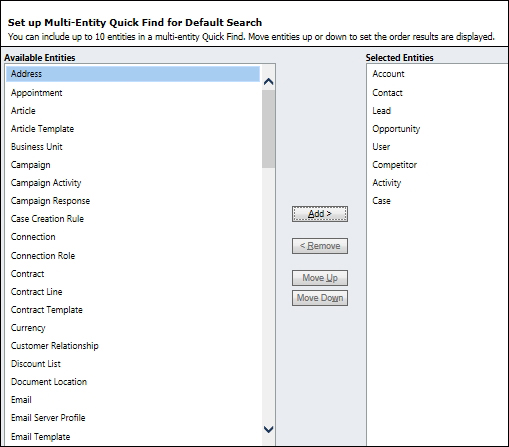
We can also configure the quick find record limit using Enable Quick Find record limits under Settings | Administration | System Settings | Set up Quick Find. By default, Yes is selected; this means when more than 10,000 records are found during search, it will display a message box to make the search more selective. Once we have the result, we can also filter it based on a specific entity using the Filter With drop-down menu:
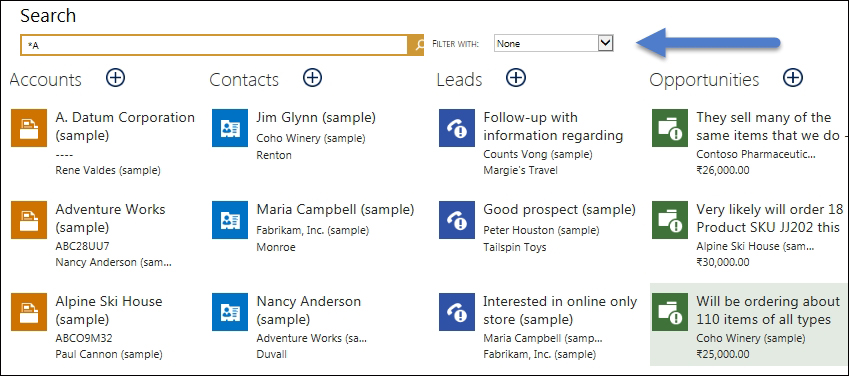
Once the result is listed, you can open the entity record by simply selecting the record or can create the new entity record using the plus sign.
This feature was also released in Microsoft Dynamics CRM 2013 initially, which helps nontechnical CRM users to implement no code business logic. While working on different business requirements, we need to implement many business-specific validations. But still, there are some generic data validations, such as hide/show form fields, making fields based on some business logic, and setting the field's default values. The business rules help us to implement these types of validation from CRM UI. The business rules can be added/modified by navigating to Settings | Solution | Components | Entities | Entity | Business Rules. We can also create/modify the business rules from the entity form editor using the Business Rules button under the Home tab in the entity form:

The business rule in Microsoft Dynamics CRM 2015 now provides the following features:
Once the business rule is defined, we need to set up its scope. A new option, Entity, is added under the scope drop down to make business logic available on the server side. If the entity option is selected, the business logic will fire on the server during the operation on the records from all the clients including any custom integration code.
Every business has some predefined business process workflows that they follow in day-to-day business. Let's take a very common scenario of the approval process. Let's assume you are a technical consultant and working in a multinational company. You need to apply for a one week vacation. As soon as you apply for leave, it will initiate a leave approval behind the scenes, which may contain different stages and subapproval of your team lead, your project manager, your project delivery manager. We can implement similar business requirements in Microsoft Dynamics CRM 2015 using the business process flow. The business process flow was introduced in CRM 2011 Polaris release initially and enhanced in Microsoft Dynamics CRM 2015. Business process flow is basically a guided approach to complete any business process, which may have different stages based on business requirements. Microsoft Dynamics CRM 2015 provides a rich editor to design for designing business process flow. You can create a business process flow by navigating to Settings | Process | New and selecting Business Process Flow under the Category drop-down menu. We can have up to 30 stages and 30 steps per business process flow:
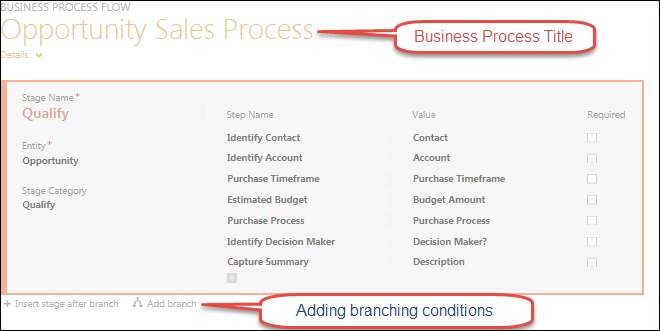
We can include multiple entities in the same business process flow and take the process flow from one entity to another entity. We can include up to five maximum entities in the business process flow. The following is the screenshot of the out-of-the-box Lead to Opportunity Sales Process business process flow:

Microsoft Dynamics CRM 2015 added support for branching logic, which allows us to switching the process stage using if conditions, the logical AND and OR operator support, which allows us to group multiple conditions and support for interacting with the business process flow using client-side scripting for developers
Tip
You can access https://msdn.microsoft.com/en-us/library/dn817874.aspx to get details about the scripting method available for the business process flow.
Another new feature added in Microsoft Dynamics CRM 2015 is hierarchy visualization of your data. In Microsoft Dynamics CRM, we can associate entities using entity relationships. Hierarchical visualization provides logical visualization of the 1:N relationship or self-relationship between entities. At present, we can have only one hierarchical relationship per entity. While setting up a relationship, we can select whether we want to use this relationship as hierarchical using the Hierarchical dropdown.
Once the relationship is set up, we can navigate to Hierarchy Settings | New under the entity node to create the hierarchy setting. As soon as the hierarchy setting is created per entity, the new button will not be available anymore because we can set up only one hierarchy setting per entity:
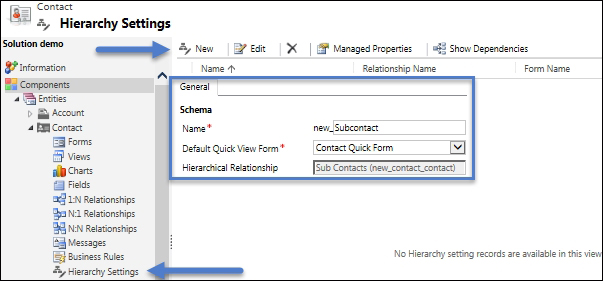
Once the hierarchy setting is set up and the record is associated, we can see a logical relationship visualization using the hierarchy icon on the entity grid view or entity form. The following screen represents the hierarchy visualization for the parent account. We can see that Adventure Works (Sample) is a parent account and it has two child accounts. Data is represented in tiles, where a maximum of four fields are allowed. The data fields are represented from a default quick view form. If it has more than four fields, then only the first four fields are used for display:
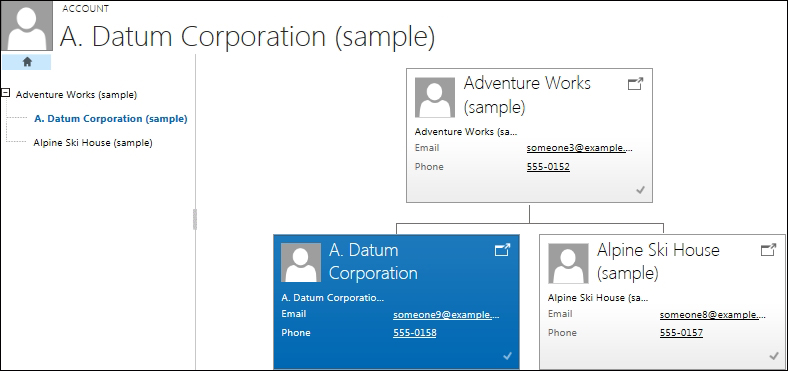
Two new query operators are also added for querying hierarchical data, which are explained as follows:
Microsoft Dynamics CRM provides a robust security model, but sometimes developers still need to write custom extensions to the security model to fulfil complex business requirements. Microsoft Dynamics CRM 2015 introduced a new hierarchical security feature that works with the existing security model and reduces the development and maintenance costs for implementing complex security requirements. There are two security models available in hierarchical security in Microsoft Dynamics CRM 2015, which are as follows:
Manager
Position
The manager hierarchical security model is based on the reporting hierarchy that can be implemented using the manager lookup in the system user entity:
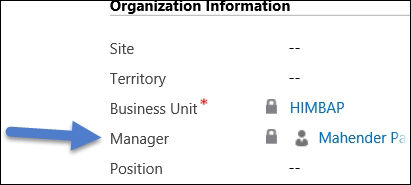
This security model facilitates managers to access the data that their reports have access to. Let's take an example of two business users Mahender Pal and Vikram Singh. Both are in the same business unit and Vikram Singh is a sales person who has user level create and read access on the account entity. Now, let's say to implement the reporting hierarchy, we need to assign Vikram as the manager of Mahender.
However, since Vikram has only user level read access on the account entity, he can't access entity records owned by Mahender's unless it is shared or assigned to him or a team where he is a member. So, if he tries to access Active Accounts, it will only show records owned by him. Now, let's enable the hierarchy security by navigating to Settings | Security and then click on Save and Close:
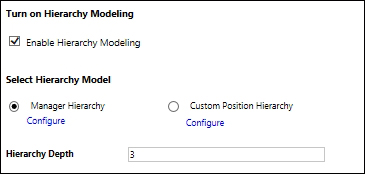
As soon as the manager hierarchical security model is applied, Vikram will be able to access the record owned by his report:
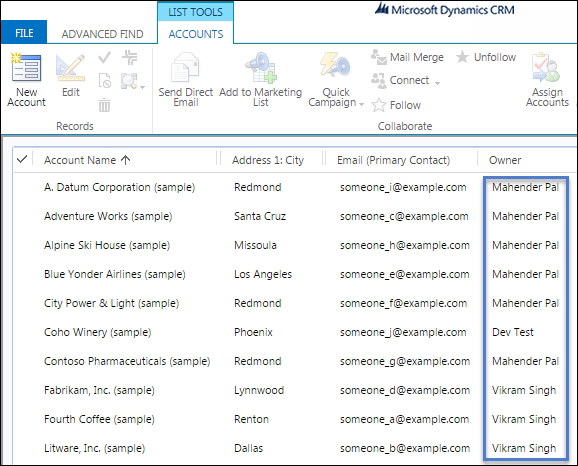
Now, Vikram will have Read, Write, Update, Append, AppendTo access to Mahender's data, who is direct report to Vikram, and read only access to Dev Test's data, who is non direct report to Vikram. While configuring the hierarchy security settings, we can define the depth property, which decides up to what level we can access the records.
The position hierarchy security model is based on the new position hierarchy that is added in Microsoft Dynamics CRM 2015. A CRM admin can define different job positions based on the business requirement and can assign the user from a different business unit to a particular position. We can add multiple users to any position, but any user can be associated with only one position. A higher position user can access the data of a lower position user similar to manager hierarchy security model irrespective of their business units. So, the higher positions will have Read, Write, Update, Append, AppendTo access to the lower positions' data and nondirect higher positions will have read-only access to the lower positions' data. We can define positions by navigating to Settings | Security | Position:
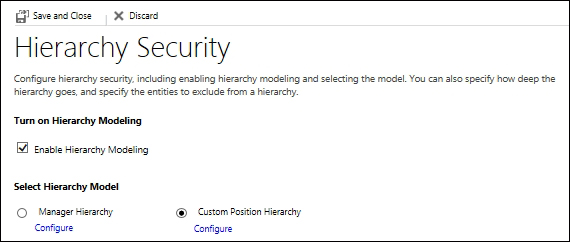
Once the positions are defined, we can configure the position hierarchy security module by selecting Custom Position Hierarchy as shown in the preceding screenshot.
While working on business requirements, most of the time we need to calculate values using different attributes and need to store them in other fields. For these type of requirements, CRM admins need to depend on CRM developers to write code. However, with the release of Microsoft Dynamics CRM 2015, CRM admins can utilize calculated and rollup fields for calculation. Next, we will introduce two new types of fields.
Calculated fields are very useful to set the calculated value to any field. Calculated fields can be used with the following data types:
Single Line of Text
Option Set
Two Options
Whole Number
Decimal Number
Currency
Date and Time
While we create a new field, we can select Field Type as Calculated to set up a calculated field, as shown in the following screenshot:
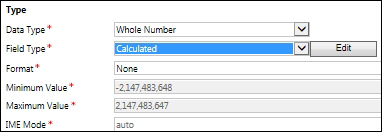
To set up a calculated formula first, we need to save the field definition and then we can click on the Edit button to set up the formula. Calculated provides an editor similar to the business rules. Let's take a scenario where we are a service-based company and allow our customers to set trail for thirty days. So, we can create two fields: trail start and trail end.
Now, we want to implement the logic when the trial date is saved, trial end data should be calculated automatically with an addition of 30 days. We can easily implement this using the calculated field, so we can set the trail end date as the calculated field and can use the formula as shown in the following screenshot to calculate the value of the trail end date field:
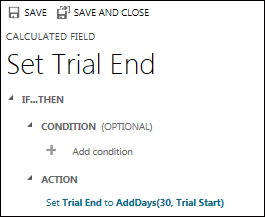
The calculated fields are calculated in a synchronous manner. So, as soon as we create our entity record, if the trail start date is there, the trail end date will be calculated automatically. The calculated fields are always read only:

We can refer to the calculated fields in charts and view, but at present we can only use up to 10 calculated attributes in charts and views. The calculated fields are also not available offline at present.
This is another type of calculated field added in Microsoft Dynamics CRM 2015, which is used for record-level aggregation from related entities record. Rollup fields are calculated using asynchronous system jobs after a 12-hour interval. If the required system administrator can configure it to run during a different interval, we can use the rollup field with the following data types:
Whole Number
Decimal Number
Currency
Date and Time
Rollup fields can be created similar to the calculated fields. We just need to select Rollup under the Field Type dropdown as shown in the following screenshot:
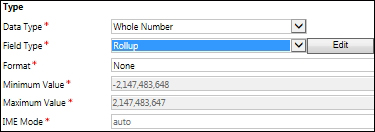
Microsoft Dynamics CRM 2015 automatically adds two more fields for every rollup field that is created:
<Field SchemaName>_Date: This is a date time field, which stores the date/time information when the rollup field was last calculated
<Field SchemaName>_State: This is the integer field that stores the state of the rollup field
Rollup fields are also available as read only in entity form. Once the rollup field is created, we can click on the Edit button to set up the formula for the rollup field. The rollup field can be used in different scenarios, for example, let's say we want to count the number of contacts for a particular account. We can simply create a rollup field and setup the formula as shown in the following screenshot:
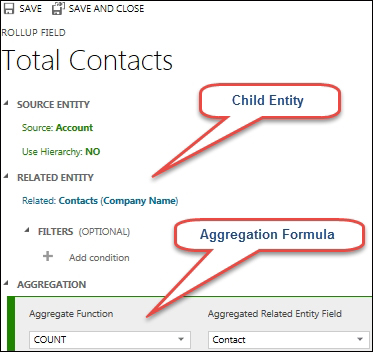
We can have 100 rollup fields per Microsoft Dynamics CRM 2015 organization and the entity can have up to 10 rollup fields, which can be used in charts, views, and reports.
With the release of CRM 2015, new offline capabilities are added in CRM for the mobile client. This feature allows us to create the record in draft mode, which is not saved to the server yet. When the device is connected to server, the record will be synched to the server. The new dashboard support is also added to tablets. We will be discussing more on the mobile client in a later chapter.
Microsoft Dynamics CRM also provides a product catalog to store the product or service information. This product catalog provides different out-of-the-box features such as configuring products, defining discount list, setting unit groups, and maintaining a price list based on the different scenarios.
With CRM 2015, many new product catalog enhancement features have been released such as:
Support for Product Families
Define Product Properties at Family level
Define Product Bundles
Price List based on Territory
New System Setting for Product
Custom Price Calculation
Support for Cross Sell and Up Sell
With CRM 2015, we can use the product family for grouping. The product family allows us to define product properties as well, which is inherited by products when added to the product family. The product family is useful especially when we want to combine similar category products in one group:
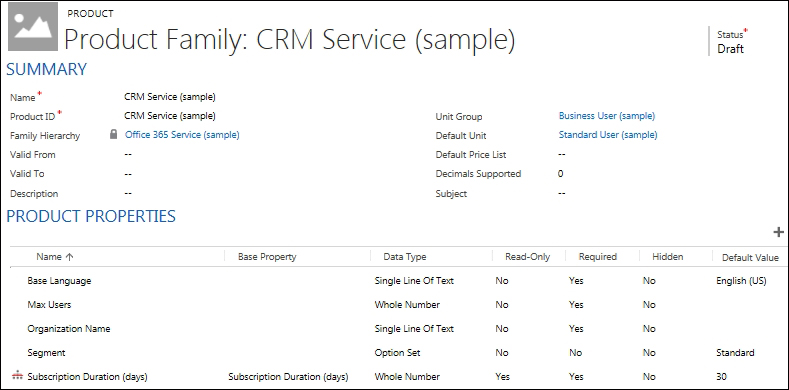
In the preceding screenshot, we can see an example of the product family, where we have different properties such as base language and max users. Another enhancement in the product catalog is the product bundle which is similar to product kits. The bundle provides more flexibility than kits used in the earlier version. We can configure if the product is required or not while selling the bundle.
Microsoft Dynamics CRM 2015 added another feature to set up product suggestions that can be used for cross sell and up sell. While setting the product, we can add related products and define their Sales Relationship Type as shown in the following screenshot:
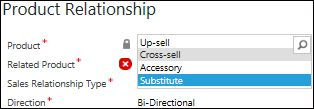
When the product is added in opportunity or quote or order, all the related products available under the suggestion box can be displayed by clicking on the Suggestion link. Microsoft Dynamics CRM 2015 also added new settings for the product catalog. For example, we can configure to set the default pricelist based on the in-built rule, which will set the pricelist based on the default price list defined for territories:
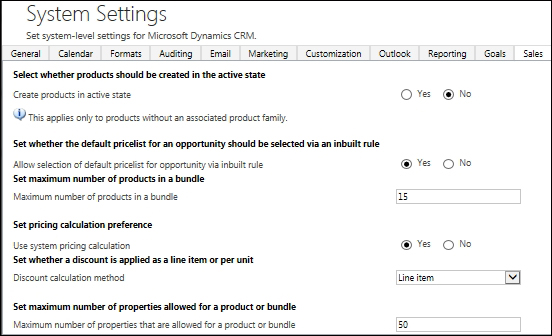
Microsoft Dynamics CRM 2015 also added a new method to define the custom pricing. Now CRM developers can write SDK code to use custom pricing, when the default system pricing is overridden.
Sometimes we may want to hide some specific field values from a specific CRM user or group of users. Field-level security helps us to implement this requirement. This feature was initially released with Microsoft Dynamics CRM 2011, but it was applicable to custom fields only. With the release of Microsoft Dynamics CRM 2015, we can now use field-level security with the system field as well. We manage field-level security by creating field-level security profile and adding user or team to that profile. We will find a default System Administrator profile, which has access to all the secured fields:
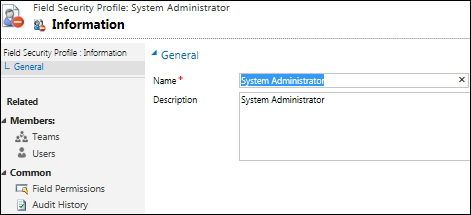
By default, all users with the system administrator role are added to this profile automatically. This profile can't be modified or deleted.
Microsoft Dynamics CRM 2015 added another true xRM feature, which allows the CRM admin to configure custom help URL in CRM UI. We can navigate to Settings | Administration | System Settings | General and configure custom help URLs:

Once this is configured, when a user clicks on the Help button from any entity record or grid, a new tab opens that displays the custom help dialog. We can also configure entity-level custom help URL settings by navigating to Settings | Customizations | Customize the System:

This is where we can select our entity where we want to use our Use custom Help dialog. First, we need to enable the Use custom Help option as shown in the preceding screenshot. After this, when the CRM user clicks on the Help button for that entity, your custom help will be displayed.
Microsoft Dynamics CRM provides an overview wizard with the welcome screen for the user when they start Microsoft Dynamics CRM the first time. Although the welcome screen contains an option to select Don't show me this again, it will still appear if you start CRM from another machine or use a new browser window:
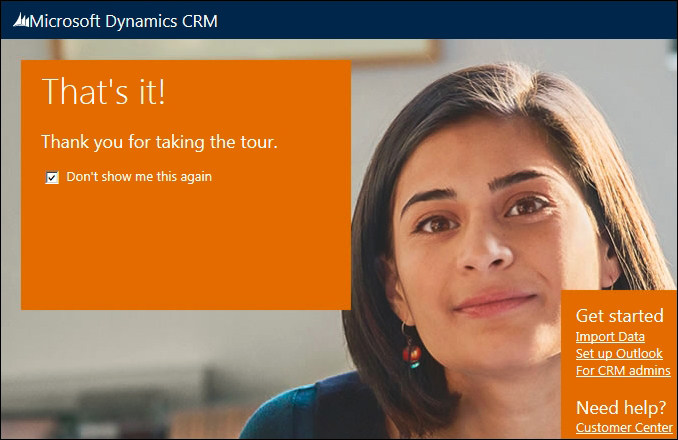
Microsoft Dynamics CRM 2015 introduced a new setting, which can be used to disable this screen for complete organization. We can navigate to Settings | Administration | System settings | General | Set whether users see navigation tour.
The quick create form feature was also released with CRM 2013, which allows us to create entity records quickly by entering key fields, which we can customize. We can use a quick create form using the Create button on the top navigation bar and New button from the lookup and subgrids.
By default, quick create forms are only enabled for some of the entities, such as account, case, contact, competitor, lead, and opportunity. We can enable the quick create feature by navigating to Settings | Customizations | Customize the System. This action will open the default solution and then we can select our entity definition under Components | Entities and enabling the option Allow quick create under the Data Services section. Once this option is available, our entity will be visible under the quick create entity lists:

Microsoft Dynamics CRM 2015 enhanced the quick create feature by allowing nested quick create options. Let's take an example. If we are creating the account record and want to create a primary contact record on the fly, we can select the New option under the lookup window and it will open a new quick create form for the contact instead of opening the contact's main entity form.
Microsoft Dynamics CRM 2015 introduced a new redesigned outlook configuration wizard. This configuration process is similar to the process in the previous version, but it is a more simplified version to CRM for outlook installation.
Note
You can download CRM for outlook from http://www.microsoft.com/en-us/download/details.aspx?id=45015.
Microsoft Dynamics CRM 2015 also added a new enhancement to Service Level Agreement (SLA). In Microsoft Dynamics CRM 2015, the new option pause and resume added SLA with timer support. This helps to track how long a case was on-hold or awaiting a customer response.
We can configure the status of the cases when SLA will be paused. To check this status, navigate to Settings | Administration | System Settings and configure the settings as shown in the following screenshot:
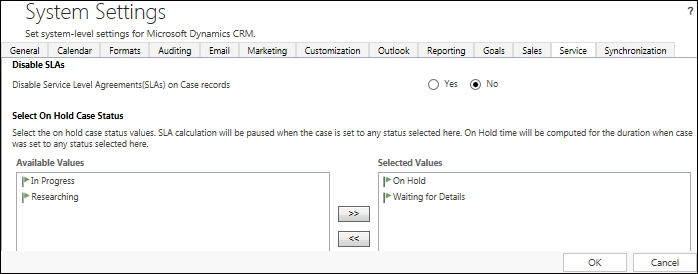
As we configured to status On Hold and Waiting for Details, the SLA timer will be paused during these statuses and when the status will be moved back to In Progress or Researching, the SLA timer will again start working.
Microsoft Dynamics CRM 2015 also added new fields for configuring the synchronization setting. New fields for appointment attachments, additional contact, and tasks can be configured as shown in the following screenshot:
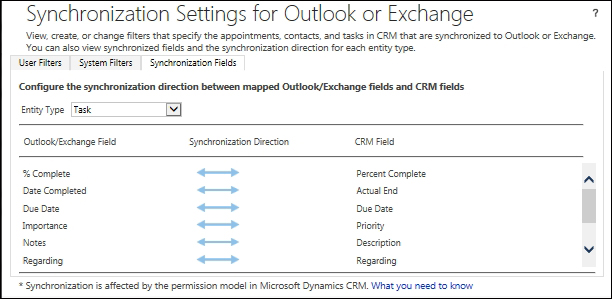
Navigate to Settings | Email Configuration | Email Configuration Settings to configure the additional fields.
In this chapter, we learned about new Microsoft Dynamics CRM 2015 features such as nested quick create enhanced business process flow and business rule enhancement. We discussed different deployment options with clients that we can use to access CRM 2015. We also discussed software and hardware requirements for CRM 2015 with different upgrade options. Finally, we discussed the new license model introduced in CRM 2015.
In the next chapter, we will learn the customization feature in MS CRM 2015 and start creating a sample application for the training company.




















